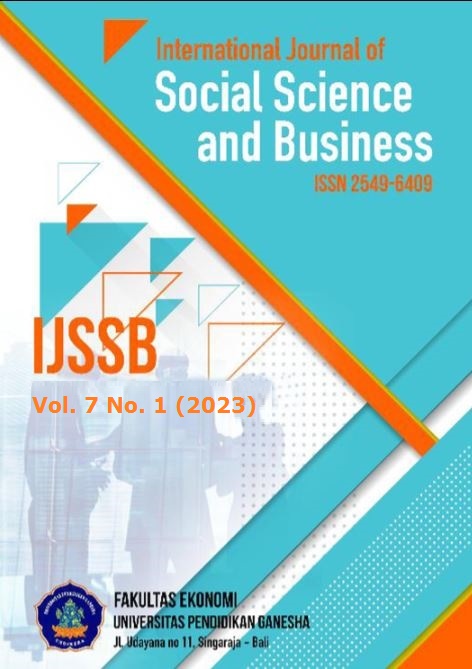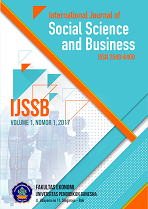Adoption of Fintech by Labuhanbatu Students
DOI:
https://doi.org/10.23887/ijssb.v7i1.53599Keywords:
Fintech, Perceive Ease of Use, Perceive UsefulnessAbstract
The financial services industry is witnessing massive structural changes due to various technological innovations. The ubiquitous innovation known as Financial Technology (Fintech) is changing traditional banking and corporate finance. The use of Fintech has now become widespread and has changed people's financial patterns. Fintech provides various conveniences in various activities related to payments, money transfers, and even the management of savings itself, even the use of Fintech currently plays a significant role in the progress of small and medium enterprises. In various big cities in Indonesia, small community-owned businesses are familiar with using Fintech as payment. However, based on the observations of researchers, it is known that in Labuhanbatu, the use of Fintech is still infrequent. Therefore, this study aims to analyses the factors which affect the intention to use Fintech in Labuhanbatu. This study uses a quantitative approach and data analysis using the Smart PLS3 software. The sample in this study was students in Labuhanbatu. This study uses the PLS technique which is a variance-based SEM which is suitable for this study due to the sample size and complexity of the hypothesis. From the study's results, it was found that all predictive variables had a positive and significant influence on the intention to use Fintech by Labuhanbatu students.
References
Ajzen, I., & Madden, T. J. (1986). Prediction of goal-directed behavior: Attitudes, intentions, and perceived behavioral control. Journal of Experimental Social Psychology, 22(5), 453–474. https://doi.org/https://doi.org/10.1016/0022-1031(86)90045-4. DOI: https://doi.org/10.1016/0022-1031(86)90045-4
Al-Okaily, M., Al Natour, A. R., Shishan, F., Al-Dmour, A., Alghazzawi, R., & Alsharairi, M. (2021). Sustainable FinTech innovation orientation: a moderated model. Sustainability, 13(24), 13591. https://doi.org/10.3390/su132413591. DOI: https://doi.org/10.3390/su132413591
Arpaci, I., & Basol, G. (2020). The impact of preservice teachers’ cognitive and technological perceptions on their continuous intention to use flipped classroom. Education and Information Technologies, 3503–3514. https://doi.org/10.1007/s10639-020-10104-8. DOI: https://doi.org/10.1007/s10639-020-10104-8
Barbu, C. M., Florea, D. L., Dabija, D.-C., & Barbu, M. C. R. (2021). Customer Experience in Fintech. Journal of Theoretical and Applied Electronic Commerce Research, 16(5), 1415–1433. https://doi.org/10.3390/jtaer16050080. DOI: https://doi.org/10.3390/jtaer16050080
Broby, D. (2019). Strategic Fintech. Journal Centre for Financial Regulation and Innovation, 1–13. https://papers.ssrn.com/sol3/papers.cfm?abstract_id=3404518.
Cooper, D. R., & Schindler, P. S. (2014). Business Research Methods 12th Edition. In Business Research Methods.
Davis, F. D. (1989). Perceived Usefulness, Perceived Ease of Use, and User Acceptance of Information Technology. MIS Quarterly, 13(3), 319–339. https://doi.org/10.2307/249008. DOI: https://doi.org/10.2307/249008
Feng, T., Tien, C., Feng, Z., & Lai, P. (2014). Web Site Quality and Online Trading Influences on Customer Acceptance of Securities Brokers. 19(March 1997), 6126. https://doi.org/10.6126/APMR.2014.19.1.02.
Glosten, L., & Rauterberg, G. (2018). Disrupting Finance FinTech and Strategy in the 21st Century. In The New Stock Market. https://doi.org/10.7312/fox-18196-006. DOI: https://doi.org/10.7312/fox-18196
Hair, Joe F., Sarstedt, M., Hopkins, L., & Kuppelwieser, V. G. (2014). Partial least squares structural equation modeling (PLS-SEM): An emerging tool in business research. European Business Review, 26(2), 106–121. https://doi.org/10.1108/EBR-10-2013-0128. DOI: https://doi.org/10.1108/EBR-10-2013-0128
Hair, Joseph F., Risher, J. J., Sarstedt, M., & Ringle, C. M. (2019). When to use and how to report the results of PLS-SEM. European Business Review, 31(1), 2–24. https://doi.org/10.1108/EBR-11-2018-0203. DOI: https://doi.org/10.1108/EBR-11-2018-0203
He, D., Leckow, R., Haksar, V., Mancini-, T., Jenkinson, N., Kashima, M., Khiaonarong, T., Rochon, C., & Tourpe, H. (2017). Fintech and Financial Services : Initial Considerations. International Monetary Fund.
Jiang, C., Zhao, W., Sun, X., Zhang, K., Zheng, R., & Qu, W. (2016). The effects of the self and social identity on the intention to microblog: An extension of the theory of planned behavior. Computers in Human Behavior, 64, 754–759. https://doi.org/https://doi.org/10.1016/j.chb.2016.07.046. DOI: https://doi.org/10.1016/j.chb.2016.07.046
Jiang, M. Y.-C., Jong, M. S.-Y., Lau, W. W.-F., Meng, Y.-L., Chai, C.-S., & Chen, M. (2021). Validating the General Extended Technology Acceptance Model for E-Learning: Evidence From an Online English as a Foreign Language Course Amid COVID-19. Frontiers in Psychology, 12, 671615. https://doi.org/10.3389/fpsyg.2021.671615. DOI: https://doi.org/10.3389/fpsyg.2021.671615
Kaba, B., & Touré, B. (2014). Understanding Information and Communication Technology Behavioral Intention to Use : Applying the UTAUT Model to Social Networking Site Adoption by Young People in a Least Developed Country. 65(8), 1662–1674. https://doi.org/10.1002/asi. DOI: https://doi.org/10.1002/asi.23069
Kline, R. B. (2011). Principles and practice of structural equation modeling, 3rd ed. In Principles and practice of structural equation modeling, 3rd ed. Guilford Press.
Kumar, P., Pillai, R., Kumar, N., & Tabash, M. I. (2022). The interplay of skills, digital financial literacy, capability, and autonomy in financial decision making and well-being. Borsa Istanbul Review. https://doi.org/10.1016/j.bir.2022.09.012. DOI: https://doi.org/10.1016/j.bir.2022.09.012
Lee, I., & Shin, Y. J. (2018). Fintech: Ecosystem, business models, investment decisions, and challenges. Business Horizons, 61(1), 35–46. https://doi.org/10.1016/j.bushor.2017.09.003. DOI: https://doi.org/10.1016/j.bushor.2017.09.003
Leong, C., Tan, B., Xiao, X., Tan, F. T. C., & Sun, Y. (2017). Nurturing a FinTech ecosystem: The case of a youth microloan startup in China. International Journal of Information Management, 37(2), 92–97. https://doi.org/https://doi.org/10.1016/j.ijinfomgt.2016.11.006. DOI: https://doi.org/10.1016/j.ijinfomgt.2016.11.006
McKim, C. A. (2017). The Value of Mixed Methods Research: A Mixed Methods Study. Journal of Mixed Methods Research, 11(2). https://doi.org/10.1177/1558689815607096. DOI: https://doi.org/10.1177/1558689815607096
Mention, A. L. (2019). The Future of Fintech. Research Technology Management. Research Technology Management, 62(4), 59–63. https://doi.org/10.1080/08956308.2019.1613123. DOI: https://doi.org/10.1080/08956308.2019.1613123
Nurhayati, S., Nurjamil, N., & Fadhillah, M. H. (2022). Measuring Opportunities and Challenges in Dispute Resolution of Fintech Sharia Business Through LAPS. Batulis Civil Law Review, 3(1), 1–7. https://doi.org/10.47268/ballrev.v3i1.929. DOI: https://doi.org/10.47268/ballrev.v3i1.929
Ooi, K., & Tan, G. W.-H. (2016). Mobile technology acceptance model: An investigation using mobile users to explore smartphone credit card. Expert Syst. Appl., 59, 33–46. https://doi.org/10.1016/j.eswa.2016.04.015. DOI: https://doi.org/10.1016/j.eswa.2016.04.015
Palinggi, S., & Allolinggi, L. R. (2020). Analisa Deskriptif Industri Fintech di Indonesia: Regulasi dan Keamanan Jaringan dalam Perspektif Teknologi Digital. Ekonomi Dan Bisnis, 6(2), 177. https://doi.org/10.35590/jeb.v6i2.1327. DOI: https://doi.org/10.35590/jeb.v6i2.1327
Palmié, M., Wincent, J., Parida, V., & Caglar, U. (2020). The evolution of the financial technology ecosystem: An introduction and agenda for future research on disruptive innovations in ecosystems. Technological Forecasting and Social Change, 151. https://doi.org/10.1016/j.techfore.2019.119779. DOI: https://doi.org/10.1016/j.techfore.2019.119779
Persada, S. F., Miraja, B. A., & Nadlifatin, R. (2019). Understanding the Generation Z Behavior on D-Learning: A Unified Theory of Acceptance and Use of Technology (UTAUT) Approach. International Journal of Emerging Technologies in Learning (IJET), 14(05 SE-Papers), 20–33. https://doi.org/10.3991/ijet.v14i05.9993. DOI: https://doi.org/10.3991/ijet.v14i05.9993
Prasojo, L. D., Habibi, A., Mukminin, A., Sofyan, Indrayana, B., & Anwar, K. (2020). Factors influencing intention to use web 2.0 in Indonesian vocational high schools. International Journal of Emerging Technologies in Learning, 15(5), 100–118. https://doi.org/10.3991/ijet.v15i05.10605. DOI: https://doi.org/10.3991/ijet.v15i05.10605
Purwanto, A. (2020). Revealing the Intervening Effect of Fintech Lending between Entrepreneurial Education and Entrepreneurial Intentions. . International Journal of Advanced Science and Technology. https://papers.ssrn.com/sol3/papers.cfm?abstract_id=3986615.
Qekaj-Thaqi, A., & Thaqi, L. (2021). The Importance of Information and Communication Technologies (ICT) during the COVID-19—Pandemic in Case of Kosovo (Analytical Approach of Students Perspective). OALib, 08(07), 1–15. https://doi.org/10.4236/oalib.1106996. DOI: https://doi.org/10.4236/oalib.1106996
Reinartz, W., Haenlein, M., & Henseler, J. (2009). Intern . J . of Research in Marketing An empirical comparison of the ef fi cacy of covariance-based and variance-based SEM. International Journal of Research in Marketing, 26(4), 332–344. https://doi.org/10.1016/j.ijresmar.2009.08.001. DOI: https://doi.org/10.1016/j.ijresmar.2009.08.001
Ribeiro, N., Nguyen, T., Duarte, A. P., Torres de Oliveira, R., & Faustino, C. (2021). How managerial coaching promotes employees’ affective commitment and individual performance. International Journal of Productivity and Performance Management, 70(8), 2163–2181. https://doi.org/10.1108/IJPPM-10-2018-0373. DOI: https://doi.org/10.1108/IJPPM-10-2018-0373
Shin, D.-H. (2009). Towards an understanding of the consumer acceptance of mobile wallet. Computers in Human Behavior, 25(6), 1343–1354. https://doi.org/https://doi.org/10.1016/j.chb.2009.06.001. DOI: https://doi.org/10.1016/j.chb.2009.06.001
Suni Astini, N. K. (2020). Tantangan Dan Peluang Pemanfaatan Teknologi Informasi Dalam Pembelajaran Online Masa Covid-19. Cetta: Jurnal Ilmu Pendidikan, 3(2), 241–255. https://doi.org/10.37329/cetta.v3i2.452. DOI: https://doi.org/10.37329/cetta.v3i2.452
Venkatesh, V., & Davis, F. D. (2000). A Theoretical Extension of the Technology Acceptance Model: Four Longitudinal Field Studies. Management Science, 46(2), 186–204. https://doi.org/10.1287/mnsc.46.2.186.11926. DOI: https://doi.org/10.1287/mnsc.46.2.186.11926
Weston, R., & Gore, P. A. (2006). A Brief Guide to Structural Equation Modeling. The Counseling Psychologist, 34(5), 719–751. https://doi.org/10.1177/0011000006286345. DOI: https://doi.org/10.1177/0011000006286345
Yuniarti, S., & Rasyid, A. (2020). Consumer Protection in Lending Fintech Transaction in Indonesia: Opportunities and Challenges. Journal of Physics: Conference Series, 1477(5). https://doi.org/10.1088/1742-6596/1477/5/052016itle. DOI: https://doi.org/10.1088/1742-6596/1477/5/052016
Downloads
Published
How to Cite
Issue
Section
License
Copyright (c) 2022 Ade Parlaungan Nasution, Yudi Prayoga; Muhammad Yasir Arafat Pohan, Zulkifli Musannif Efendi Siregar

This work is licensed under a Creative Commons Attribution-ShareAlike 4.0 International License.











